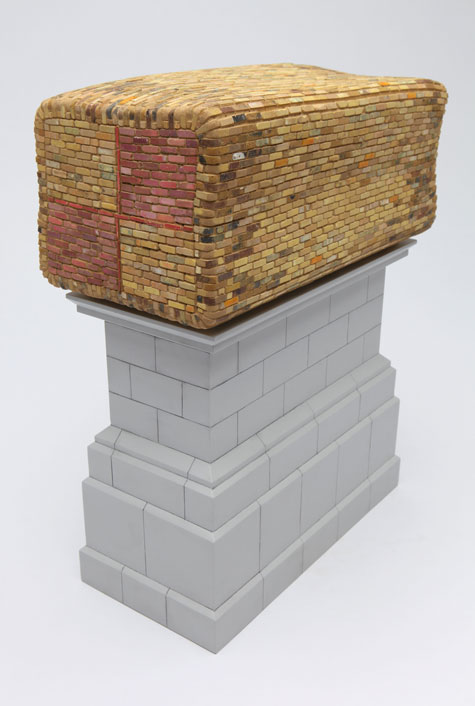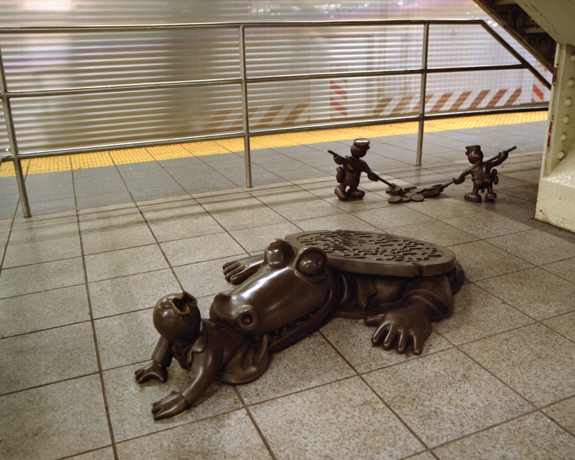
Brian Griffiths, "Battenberg," maquette, 2010
Public art is rubbish. Starting from that premise is the best possible pre-emptive strike against disappointment. Don’t expect public art to be any good and you’ll be surprised when it actually is. Which it never is. Which it sometimes is. Public art needs its own completely separate language of appreciation from that conventionally used for contemporary art. In a sense, public art is the closest thing we have, in experiential terms, to western religious art of the Christian era: objects and images that form part of the fabric of nearly everyone’s daily experience, noticed or not. Public art might, at best, be a ladder to thought or a rethinking of urban space (although I’m not sure why urban space needs to be rethought; it’s just that you’re always told it should be). For the most part, though, it isn’t. It doesn’t do anything. It’s just there. At best, it may provide a momentary pause between dermatology appointments or a useful meeting spot for a blind date, but it’s rarely much more than that, simply (I’d suggest) because it’s just too embarrassing to be standing stroking your chin contemplatively in a public place. Public art knows this, and tries not to make too many demands on your brain, while making an immediate visual zing that’s useful when you’re giving directions. (Now that there’s SatNav, maybe we don’t need any more public art).
The most exemplary recent example in London was an invasion of squatting brightly coloured elephant sculptures that appeared across parks and plazas, made and sold for an elephant charity. While the charity no doubt does sterling and admirable work, as public art it was sadly symptomatic. Scant of imagination and artistic interest, it just looked a bit sad and wacky, the sort of thing Jerry Garcia might have in his downstairs toilet.
The central pitfall of public art is the word public. Public art depends upon a small proportion of people (funding bodies, government, galleries, museums, and artists themselves) making decisions on behalf of a much larger proportion of people (everyone else). If the decision-making tips more to the benefit of the former, you have Stalinist public sculpture, glowering down at the populace; to the latter, and you have a mealy-mouthed approach that loves to be loved. Both approaches talk down to their audience, in different and equally excruciating ways. But it does work, sometimes, against all the odds. My favorite public works of art from recent times, Tom Otterness’s Life Underground sculptures at the 14th Street and 8th Avenue subway station in New York, are the best possible case for the defense of public art. They can be experienced briefly, enjoyed repeatedly and contemplated leisurely. Nothing about them depends upon the theoretical safety net of the cloistered world of the contemporary art gallery, and they employ a visual language familiar to anyone who’s aware of the Doozers from Fraggle Rock. Their satirical import is pretty self-evident – i.e. creepy cash-bag-headed lobster attempts to separate parents from their child – but the breadth and burlesque of their satire is made necessary by the site itself.

Tom Otterness, "Life Underground" (2000)
The debate around public art – the it’s-rubbish camp versus the it-isn’t camp, in a nutshell – has been made a mainstream discussion in the UK, partly because of the foregrounding of the is-it-art debate (which is what it all comes down to, ultimately) by the huge success of Tate Modern (about which much more here), but partly because of the Fourth Plinth commissions in Trafalgar Square (about which much, much more here). The six new ideas for the always-previously-vacant plinth, by Art21’s own Allora & Calzadilla, Elmgreen & Dragset, Katharina Fritsch, Brian Griffiths, Hew Locke and Mariele Neudecker, are a lesson in how and why public art works, when it does.
The proposals generally take one of the two approaches established by previous occupants of the plinth: either tongue-in-cheek references to the existing figurative works on the other plinths (a precedent set up by Quinn and Wallinger and continued in Elmgreen & Dragset’s boy on a rocking horse, Locke’s carnivalesque equestrian sculpture, and Fritsch’s big blue cock), or maquette-like blow-ups of self-consciously “humble” objects (from Whiteread and Shonibare to Allora & Calzadilla’s big silver organ – spot the theme, kids! – and Griffith’s slab of cake in bricks). Neudecker’s mountain range in the shape of the British Isles is the only one to make a decisive break from previous traditions (although its hovering, topographical/geographical quality is somewhat reminiscent of Thomas Schutte’s glass modernist hotel plan). It seems unlikely, given the plinth’s proximity to the National Gallery, that Allora & Calzadilla’s project – a working ATM set into the base of the plinth, the operation of which causes the organ to blast out some triumphal chords – will be one of the two chosen (I may well be wrong). It’s a kitschy explosion of gold and silver whose ecclesiastical overtones don’t sit that well with the square and its history. For the same reason, the Fritsch – a cockerel in what is possibly IKB ultramarine – seems likely to ruffle feathers (“LOL”!) over its employment of the French national symbol.
I’m willing to bet that the Elmgreen & Dragset will be taken on, given its bathetic/heroic dichotomy that proved successful for Quinn’s Alison Lapper and Wallinger’s Christ; it’s a pretty facile work, though, and its self-conscious playfulness is a step away from snide. I’m more willing to bet on the Griffiths, a squat, fat, defiantly horizontal cake of Victorian origin, made using Victorian pink, yellow, and blue bricks, that manages to reference Claes Oldenberg (perhaps the 20th century’s greatest public sculptor), British colonial history, obesity, tea-time, consumerism and childhood. Griffiths’s work does – and, I hope, will do – for Trafalgar Square what Otterness’s work has done for the New York subway station: cater, without compromise, to a diversity of experiences (fast/slow, one-off/daily), and be, unexpectedly, not rubbish.



